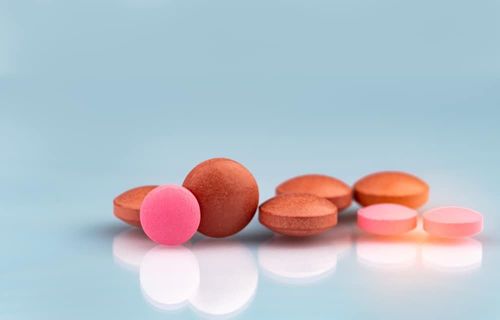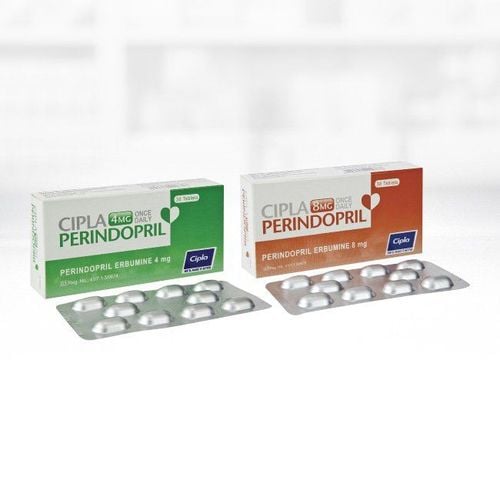This is an automatically translated article.
Renatab drug is indicated in the treatment of heart failure and hypertension. So how to use Renatab drug? What precautions should be taken when using this drug? Let's find out the necessary information about the drug Renatab through the article below.
1. What is Renatab?
Name of the drug: Renatab 5, Renatab 10 (depending on the content)
Ingredients: Each Renatab tablet has the main ingredient of Enalapril with the content of 5mg and excipients just enough.
Group of drugs: Cardiovascular drugs.
Dosage form: Film coated tablets.
SKU: VD-29205-18.
Manufacturer: Pharmaceutical and biomedical joint stock company.
Packing: A box of 3 blisters, each blister of 10 film-coated tablets.
2. Indications of the drug Renatab
2.1 What does Renatab 5 do? Renatab 5 contains the active ingredient Enalapril maleate, which belongs to the ACE inhibitor group, preventing the conversion from Angiotensin I to Angiotensin II, helping blood vessels dilate for easy blood circulation. Therefore, it is effective in the treatment of hypertension and heart failure. In addition, Enalapril also protects the kidneys for patients with diabetes.
2.2 Indications Renatab is indicated for the treatment of the following cases:
Treatment of heart failure levels. Treatment of high blood pressure levels: due to kidney disease, with idiopathic diabetes. Treatment and prevention of congestive heart failure. Prevention of ventricular dilatation after myocardial infarction. Patients with diabetes affecting the kidneys. 2.3 Dosage - How to take Renatab Dosage:
Treatment of primary hypertension:
Initial dose 1-4 tablets/day, divided into 1-2 times, depending on the degree of hypertension increase the dose to 8 tablets /day after 2-4 weeks of treatment. It is advisable to start with a low dose to avoid excessive hypotension. Heart failure:
Often combined with Digitalis and diuretics. The starting dose is 2.5mg / time / day, depending on the degree of heart failure to increase the dose to 4-8 tablets / time / day, divided into 1-2 times. Diabetics affecting kidney: starting dose of 1 tablet/time/day, then maintaining dose 1-4 tablets/time/day.
Usage:
Renatab is indicated for oral use. Renatab must be swallowed whole, do not break or break the tablet. Use Renatab with filtered water, do not drink with milk, juice to limit adverse interactions. Renatab can be taken before or after meals, food does not affect the bioavailability of the drug. 2.4 Management of overdose, missed dose Overdose:
In an emergency, Renatab should be stopped and taken to the nearest medical facility for treatment when there are unusual symptoms.
Missed dose:
If you miss a dose, take it as soon as possible. If it is almost time for the next dose, skip the missed dose and take the next dose. Do not make up for an overdose.
3. Renatab drug side effects
During the use of Renatab, patients may experience some unwanted effects such as:
Common: headache, dizziness, confusion, cough, sore throat, abdominal pain, indigestion, body fatigue, nausea, vomiting, diarrhea, constipation, increased levels of potassium and creatinine in the blood, excessively low blood pressure, arrhythmia, sleep disturbances.
Uncommon: anemia, neutropenia, pancytopenia, mental stress, dyspnea or asthma, rhinitis, hypoglycemia, peptic ulcer disease.
Rare: allergic reactions, urticaria, skin rash, hypersensitivity, alopecia, increased liver enzymes, gynecomastia syndrome in men, decreased libido, liver failure, renal failure, oliguria.
Inform the doctor about the side effects encountered during the use of Renatab for timely treatment.
4. Notes when using Renatab
4.1 Contraindications The drug is contraindicated for people who are sensitive to any of the ingredients, people with aortic stenosis and renal artery stenosis, people with a history of hypotension.
4.2 Notes and cautions Caution when using Renatab for people who turn off the left ventricular valve and the blood pump, avoid using it in cardiogenic shock and vascular occlusion. For patients with renal failure, on dialysis, vomiting or severe diarrhea, taking diuretics, it is necessary to monitor and adjust the dose appropriately. Renatab should be discontinued if the cough persists for a long time and change to another drug. Do not use Renatab drug with patients with liver failure, orthostatic hypotension. Precautions for use in pregnant women and nursing mothers
Pregnant women: Renatab drug has not been proven safe in pregnant women, only used when benefits outweigh toxicity, no drugs. alternative, consult a physician before use.
Lactating women: Renatab is excreted in breast milk, but the effect of the drug on the infant has not been determined, so it should not be used in nursing women.
5. Drug interactions
Possible drug interactions when using Renatab are:
When Renatab is combined with other antihypertensive drugs, it can cause excessive lowering of blood pressure, including orthostatic blood pressure. Concomitant use with sympathomimetic bronchodilators or non-steroidal anti-inflammatory drugs may reduce the blood pressure lowering effect. Renin-releasing agents increase the bioavailability of Enalapril. The drug Renatab increases the concentration of lithium in the blood, which is prone to toxicity. Enalapril used with oral contraceptives causes damage to blood vessels, difficult to control blood pressure. The article has provided information on what Renatab is used for, dosage and precautions for use. To ensure safety for your health and maximize the effectiveness of your treatment, you need to take Renatab exactly as directed by your doctor. Store Renatab medicine in a dry place, the temperature does not exceed 30 degrees Celsius and out of the reach of small children.
Please dial HOTLINE for more information or register for an appointment HERE. Download MyVinmec app to make appointments faster and to manage your bookings easily.













